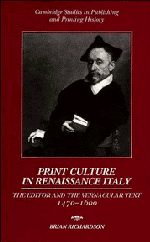Book contents
- Frontmatter
- Contents
- Preface
- Acknowledgements
- Abbreviations
- Note on transcription
- 1 Printers, authors and the rise of the editor
- 2 Editors and their methods
- 3 Humanists, friars and others: editing in Venice and Florence, 1470–1500
- 4 Bembo and his influence, 1501–1530
- 5 Venetian editors and ‘the grammatical norm’, 1501–1530
- 6 Standardization and scholarship: editing in Florence, 1501–1530
- 7 Towards a wider readership: editing in Venice, 1531–1545
- 8 The editor triumphant: editing in Venice, 1546–1560
- 9 In search of a cultural identity: editing in Florence, 1531–1560
- 10 Piety and elegance: editing in Venice, 1561–1600
- 11 A ‘true and living image’: editing in Florence, 1561–1600
- Conclusion
- Notes
- Select bibliography
- Index of Italian editions 1470–1600
- Index of manuscripts and annotated copies
- General index
2 - Editors and their methods
Published online by Cambridge University Press: 01 June 2011
- Frontmatter
- Contents
- Preface
- Acknowledgements
- Abbreviations
- Note on transcription
- 1 Printers, authors and the rise of the editor
- 2 Editors and their methods
- 3 Humanists, friars and others: editing in Venice and Florence, 1470–1500
- 4 Bembo and his influence, 1501–1530
- 5 Venetian editors and ‘the grammatical norm’, 1501–1530
- 6 Standardization and scholarship: editing in Florence, 1501–1530
- 7 Towards a wider readership: editing in Venice, 1531–1545
- 8 The editor triumphant: editing in Venice, 1546–1560
- 9 In search of a cultural identity: editing in Florence, 1531–1560
- 10 Piety and elegance: editing in Venice, 1561–1600
- 11 A ‘true and living image’: editing in Florence, 1561–1600
- Conclusion
- Notes
- Select bibliography
- Index of Italian editions 1470–1600
- Index of manuscripts and annotated copies
- General index
Summary
We have been considering so far the relationships between editors and those for and with whom they worked. We now need to look at the factors which shaped their methods and results. Firstly, we can examine some contemporary attitudes towards the transmission of written texts by considering the standards for the copying of vernacular texts which had been established in the manuscript age and by assessing the nature of the guidance which classical textual criticism offered to vernacular editors when printing began. Secondly, we can look at practical constraints arising specifically from the aims and methods of the printing industry.
From the earliest days of the circulation of vernacular texts in manuscript, scribes would often deliberately adapt the language or even the contents of their exemplars according to personal tastes. It is worth analysing briefly the ways in which they treated their sources, since their methods provided the natural model for editors when texts began to circulate in printed as well as in handwritten form.
One influence for change was that of the place of copying of a text, especially when this differed from its place of composition. A well-known example is that of the Tuscanization of the poets of the thirteenth-century Sicilian school which is found in the three earliest surviving Tuscan canzonieri, and which was very probably already present in their archetype. Tuscan authors of the same century were themselves subject to linguistic adaptation.
- Type
- Chapter
- Information
- Print Culture in Renaissance ItalyThe Editor and the Vernacular Text, 1470–1600, pp. 19 - 27Publisher: Cambridge University PressPrint publication year: 1994

